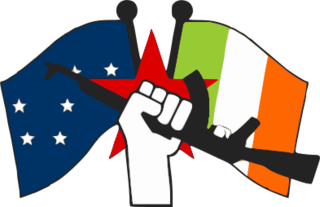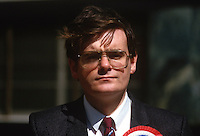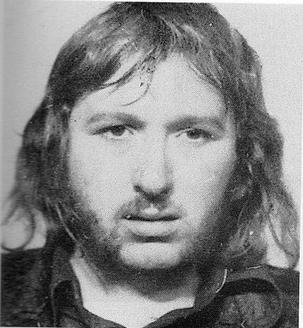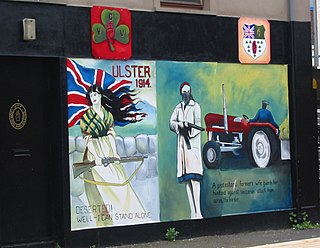
The Irish National Liberation Army is an Irish republican socialist paramilitary group formed on 8 December 1974, during the 30-year period of conflict known as "the Troubles". The group seeks to remove Northern Ireland from the United Kingdom and create a socialist republic encompassing all of Ireland. With membership estimated at 80–100 at their peak, it is the paramilitary wing of the Irish Republican Socialist Party (IRSP).

The Ulster Volunteer Force (UVF) is an Ulster loyalist paramilitary group based in Northern Ireland. Formed in 1965, it first emerged in 1966. Its first leader was Gusty Spence, a former Royal Ulster Rifles soldier from Northern Ireland. The group undertook an armed campaign of almost thirty years during The Troubles. It declared a ceasefire in 1994 and officially ended its campaign in 2007, although some of its members have continued to engage in violence and criminal activities. The group is a proscribed organisation and is on the terrorist organisation list of the United Kingdom.

The Ulster Defence Association (UDA) is an Ulster loyalist paramilitary group in Northern Ireland. It was formed in September 1971 as an umbrella group for various loyalist groups and undertook an armed campaign of almost 24 years as one of the participants of the Troubles. Its declared goal was to defend Ulster Protestant loyalist areas and to combat Irish republicanism, particularly the Provisional Irish Republican Army (IRA). In the 1970s, uniformed UDA members openly patrolled these areas armed with batons and held large marches and rallies. Within the UDA was a group tasked with launching paramilitary attacks that used the cover name Ulster Freedom Fighters (UFF) so that the UDA would not be outlawed. The British government proscribed the UFF as a terrorist group in November 1973, but the UDA itself was not proscribed until August 1992.

The Irish People's Liberation Organisation was a small Irish socialist republican paramilitary organisation formed in 1986 by disaffected and expelled members of the Irish National Liberation Army (INLA), whose factions coalesced in the aftermath of the supergrass trials. It developed a reputation for intra-republican and sectarian violence as well as criminality, before being forcibly disbanded by the Provisional Irish Republican Army (IRA) in 1992.
Jimmy Brown was a militant Irish republican and drug dealer who was a member of Fianna Eireann, the Official IRA, then Irish Republican Socialist Party (IRSP)/ Irish National Liberation Army (INLA), and latterly of the Irish People's Liberation Organisation (IPLO).
Samuel Ward was the leader of the Irish People's Liberation Organisation's Belfast Brigade. The IPLO was formed in 1986 by disaffected and expelled members of the Irish National Liberation Army. Following its split from and feud with the INLA, the IPLO split into two factions: the 'Army Council' and the 'Belfast Brigade'.

George Seawright was a Scottish-born unionist politician in Northern Ireland and loyalist paramilitary in the Ulster Volunteer Force. He was assassinated by the Irish People's Liberation Organisation in 1987.
Gerard Steenson was an Irish republican paramilitary and a leader of the Irish People's Liberation Organization during The Troubles.
Hugh Torney was an Irish National Liberation Army (INLA) paramilitary leader best known for his activities on behalf of the INLA and Irish Republican Socialist Party (IRSP) in a feud with the Irish People's Liberation Organisation (IPLO), a grouping composed of disgruntled former INLA members, in the mid-1980s; and later an internal feud following his expulsion from the organisation and eventual death.

Robert William Bates was a Northern Irish loyalist. He was a member of the Ulster Volunteer Force and the infamous Shankill Butchers gang, led by Lenny Murphy.
The Republican Socialist Collective was a fringe Irish republican political group in Northern Ireland formed in 1986. The RSC was formed at the behest of Jimmy Brown to serve as the political arm of the Irish People's Liberation Organisation, a splinter group of the Irish National Liberation Army formed by Gerard Steenson, Jimmy Brown and Martin 'Rook' O'Prey. Ideologically the group endorsed a militant brand of revolutionary socialism.
Brian Robinson was a loyalist militant from Belfast, Northern Ireland and member of the Ulster Volunteer Force (UVF) who was witnessed killing a Catholic civilian. His death at the hands of an undercover British Army unit is one of the few from the alleged shoot-to-kill policy in Northern Ireland to have involved a loyalist victim.
James Trevor King, also known as "Kingso", was a British Ulster loyalist and a senior member of the Ulster Volunteer Force (UVF). He was commander of the UVF's "B" Company, 1st Belfast Battalion, holding the rank of lieutenant colonel. On 16 June 1994, he was one of three UVF men gunned down by the Irish National Liberation Army as he stood on the corner of Spier's Place and the Shankill Road in West Belfast, close to the UVF headquarters. His companion Colin Craig was killed on the spot, and David Hamilton, who was seriously wounded, died the next day in hospital. King was also badly injured; he lived for three weeks on a life-support machine before making the decision himself to turn it off.
John "Bunter" Graham is a long-standing prominent Ulster loyalist figure. Born in the Lower Shankill, Graham rose quickly through the ranks of the Ulster Volunteer Force (UVF), joining other UVF leaders at a rally at Stormont in 1974 to celebrate the collapse of power sharing.

The 1994 Shankill Road killings took place on 16 June 1994 when the Irish National Liberation Army (INLA) shot dead three Ulster Volunteer Force (UVF) members – high-ranking member of the UVF Belfast Brigade staff Trevor King and two other UVF members, Colin Craig and David Hamilton – on the Shankill Road in Belfast, close to the UVF headquarters. The following day, the UVF launched two retaliatory attacks. In the first, UVF members shot dead a Catholic civilian taxi driver in Carrickfergus. In the second, they shot dead two Protestant civilians in Newtownabbey, who they believed were Catholics. The Loughinisland massacre, two days later, is believed to have been a further retaliation.

The Central Bar bombing was a bomb attack on a pub in the town of Gilford near Portadown in County Down in Northern Ireland on 31 December 1975. The attack was carried out by members of the Irish National Liberation Army (INLA) using the covername "People's Republican Army" although contemporary reports also said the "Armagh unit" of the "People's Republican Army" had claimed responsibility. Three Protestant civilians were killed in the bombing.
The following is a timeline of actions during The Troubles which took place in the Republic of Ireland between 1969 and 1998. It includes Ulster Volunteer Force bombings such as the Dublin and Monaghan bombings in May 1974, and other loyalist bombings carried out in the 1970s, '80s and '90s, the last of which was in 1997. These attacks killed dozens of people and injured hundreds more. Also actions carried out by Irish republicans including bombings, prison escapes, kidnappings, and gun battles between the Gardaí (police) and the Irish Defence Forces against Republican gunmen from the Irish National Liberation Army, the Provisional Irish Republican Army, and a socialist-revolutionary group, Saor Éire. These attacks killed a number of civilians, police, soldiers, and republican paramilitaries.

The Irish National Liberation Army Belfast Brigade was the main brigade area of the Irish National Liberation Army (INLA). The other Brigade areas were in Derry which was split between two battalions, the first in Derry City, and the second battalion in south County Londonderry and County Armagh which was also split into two battalions, a south Armagh and a north Armagh battalion, with smaller units in Newry, east and west County Tyrone and south County Fermanagh.

The RTÉ Studio bombing was a 1969 bomb attack carried out by the Ulster Loyalist paramilitary group the Ulster Volunteer Force (UVF) in Dublin, Ireland. It was the first Loyalist bombing in the Republic of Ireland during the Troubles.

The Stag Inn attack was a sectarian gun attack, on 30 July 1976, carried out by a group of Belfast IRA Volunteers using the cover name Republican Action Force. Four Protestants, all civilians, the youngest being 48 years old and the eldest 70, were all killed in the attack with several others being injured. Three Catholics were killed the previous day in a Loyalist bomb attack, part of a string of sectarian attacks in Northern Ireland by different paramilitary organizations.










